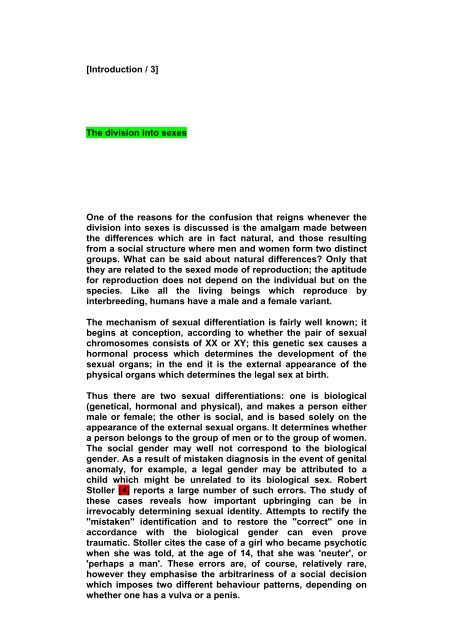emmanuel reynaud holy virility the social construction of masculinity
emmanuel reynaud holy virility the social construction of masculinity
emmanuel reynaud holy virility the social construction of masculinity
You also want an ePaper? Increase the reach of your titles
YUMPU automatically turns print PDFs into web optimized ePapers that Google loves.
[Introduction / 3]<br />
The division into sexes<br />
One <strong>of</strong> <strong>the</strong> reasons for <strong>the</strong> confusion that reigns whenever <strong>the</strong><br />
division into sexes is discussed is <strong>the</strong> amalgam made between<br />
<strong>the</strong> differences which are in fact natural, and those resulting<br />
from a <strong>social</strong> structure where men and women form two distinct<br />
groups. What can be said about natural differences? Only that<br />
<strong>the</strong>y are related to <strong>the</strong> sexed mode <strong>of</strong> reproduction; <strong>the</strong> aptitude<br />
for reproduction does not depend on <strong>the</strong> individual but on <strong>the</strong><br />
species. Like all <strong>the</strong> living beings which reproduce by<br />
interbreeding, humans have a male and a female variant.<br />
The mechanism <strong>of</strong> sexual differentiation is fairly well known; it<br />
begins at conception, according to whe<strong>the</strong>r <strong>the</strong> pair <strong>of</strong> sexual<br />
chromosomes consists <strong>of</strong> XX or XY; this genetic sex causes a<br />
hormonal process which determines <strong>the</strong> development <strong>of</strong> <strong>the</strong><br />
sexual organs; in <strong>the</strong> end it is <strong>the</strong> external appearance <strong>of</strong> <strong>the</strong><br />
physical organs which determines <strong>the</strong> legal sex at birth.<br />
Thus <strong>the</strong>re are two sexual differentiations: one is biological<br />
(genetical, hormonal and physical), and makes a person ei<strong>the</strong>r<br />
male or female; <strong>the</strong> o<strong>the</strong>r is <strong>social</strong>, and is based solely on <strong>the</strong><br />
appearance <strong>of</strong> <strong>the</strong> external sexual organs. It determines whe<strong>the</strong>r<br />
a person belongs to <strong>the</strong> group <strong>of</strong> men or to <strong>the</strong> group <strong>of</strong> women.<br />
The <strong>social</strong> gender may well not correspond to <strong>the</strong> biological<br />
gender. As a result <strong>of</strong> mistaken diagnosis in <strong>the</strong> event <strong>of</strong> genital<br />
anomaly, for example, a legal gender may be attributed to a<br />
child which might be unrelated to its biological sex. Robert<br />
Stoller [4] reports a large number <strong>of</strong> such errors. The study <strong>of</strong><br />
<strong>the</strong>se cases reveals how important upbringing can be in<br />
irrevocably determining sexual identity. Attempts to rectify <strong>the</strong><br />
''mistaken'' identification and to restore <strong>the</strong> ''correct'' one in<br />
accordance with <strong>the</strong> biological gender can even prove<br />
traumatic. Stoller cites <strong>the</strong> case <strong>of</strong> a girl who became psychotic<br />
when she was told, at <strong>the</strong> age <strong>of</strong> 14, that she was 'neuter', or<br />
'perhaps a man'. These errors are, <strong>of</strong> course, relatively rare,<br />
however <strong>the</strong>y emphasise <strong>the</strong> arbitrariness <strong>of</strong> a <strong>social</strong> decision<br />
which imposes two different behaviour patterns, depending on<br />
whe<strong>the</strong>r one has a vulva or a penis.
















